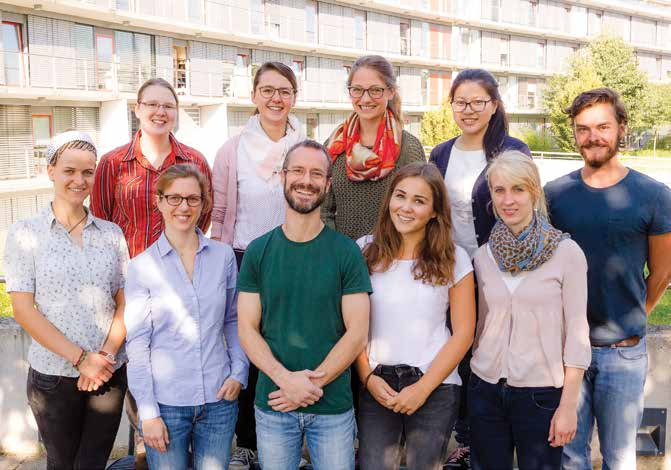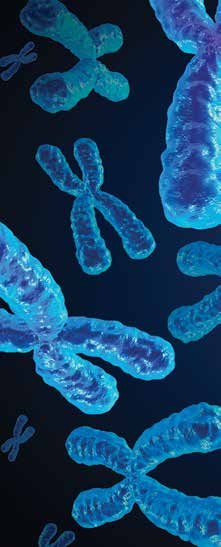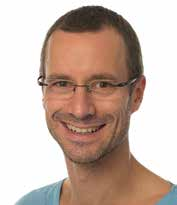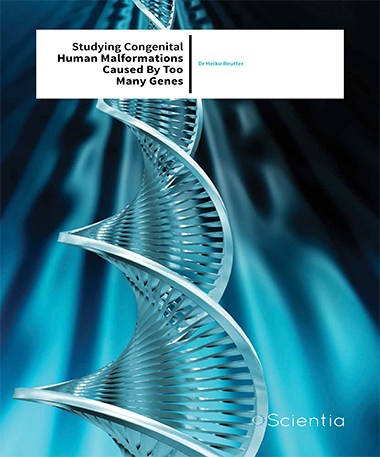Dr Heiko Reutter – Studying Congenital Human Malformations Caused By Too Many Genes
Genetics researcher Dr Heiko Reutter and his colleagues at the Institute of Human Genetics of the University of Bonn, Germany, think that some congenital malformations of the uro-rectal area, oesophagus and trachea are caused by too many copies of genes that govern the structure of those organs.

Genes Make the Man
As every school child learns, we human beings are who we are in large part because of the 46 chromosomes that carry our genetic information. We get 23 chromosomes from our mothers, 23 chromosomes from our fathers and we start our lives with a 46-page blueprint for how we are to look, grow and function. Because of the way chromosomes are passed from parents to child, we expect tall parents to have tall children, brown-eyed parents to have brown-eyed children and so on. Those chromosomes contain roughly 20,000–25,000 human protein-coding genes – the individual basic biological units of heredity – that individually code for various structural proteins, enzymes and the myriad of molecules needed for our bodies to function. It’s a complicated system that more often than not runs smoothly. Sometimes, however, defects or malfunctions in those genes can cause structural or functional problems – disease. Paediatric genetics researcher Dr Heiko Reutter has dedicated his professional life to investigating the role of gene abnormalities as a cause of some malformations found in babies at the start of their lives.
When are too many copies of a gene too much?
The topic of birth defects is a complex one. Some birth defects are caused by obvious external forces. For example, the latest worry in the news is the Zika virus, a virus that can cause microcephaly – an abnormally small head – in babies affected during pregnancy. Another defect doctors address is foetal alcohol syndrome in babies whose mothers drink during pregnancy. Perhaps the majority of birth defects, however, appear to be caused by abnormalities in the baby’s DNA that cause structural or functional abnormalities. Some of these defects seem to arise spontaneously, but many are passed down from parent to child. If a parent has an abnormal gene, it can be passed on to the baby as a genetic disease.
Usually, when one thinks of human genetic disease, you think of single mutations. After all, a change in one gene is a simplistic way to think of changes in DNA – mutations. One nucleic acid change due to, say, radiation damage, changes one gene and causes a problem. Humans were thought to have 46 chromosomes, those chromosomes had about 20,000–25,000 human proteincoding genes, and each gene was almost always present in two copies. If there is a malformation or mutation of one of those genes, disease may result. Unfortunately, things are not that simple. Scientists have now discovered that a large number of genes, perhaps 5–10% of the human genome, have a number of copies. These so-called copy number variations (CNVs) can have one, three, or even more copies. Sometimes the genes are missing altogether – a deletion. But often there is extensive copying that can cause be a cause of genetic variation.
If the CNV results in a large number of copies of the gene or parts of the gene, there may be an imbalance of the product or structure produced by that gene that causes disease. This phenomenon is of great interest to Dr Heiko Reutter, a genetics researcher at the Institute of Human Genetics of the University of Bonn. Some cases of Alzheimer’s disease and schizophrenia are thought to be associated with CNVs. As more is known about CNV, more diseases are found to be associated with abnormally large areas of CNV in one or more genes. Dr Reutter and his co-workers have found that CNV may, in fact, be associated with a variety of birth defects.
As more is known about copy number variations (CNV), more diseases are found to be associated with abnormally large areas of CNV in one or more genes. Dr Reutter and his co-workers have found that CNV may, in fact, be associated with a variety of birth defects

The team, from left to right: (upper line) Catharina Luise von Lowtzow, Alina Hilger, Johanna Magdalena Schmidt, Rong Zhang; (lower line) Greta Große, Charlotte Schramm, Heiko Reutter, Valerie Weitensteiner, Franziska Kause, Florian Marsch; (missing) Gabriel Dworschak, Thomas Bogs
On the Trail of the Causes of Birth Defects
Birth defects are perhaps one of the saddest things in the practice of medicine. We normally think of people as being overjoyed with the birth of the fine, healthy ‘bouncing baby’. But what if that baby is born with some congenital anomaly that portends a life of suffering, or at least significant difficulty? Dr Reutter has personally seen babies born with, for example, genitourinary deformities like exstrophy of the bladder. The birth defect called bladder exstrophy is the protrusion of the urinary bladder through a defect in the abdominal wall, often associated with abnormalities of the pelvic bones, pelvic muscles, and sex organs. While bladder exstrophy is thankfully rare, when it occurs it can be a cause of great disability for babies, often condemning them to multiple surgeries and perhaps some permanent dysfunction. Even if babies with bladder exstrophy are successfully treated and ultimately have children of their own, the risk of similar malformations in their own babies is increased about 400-fold. Plus, there are higher concordance rates among monozygotic compared to dizygotic twin pairs. Clearly this is a genetic disease.
Early on in his career, Dr Reutter took an interest in the genetics of bladder exstrophy and related defects. He connected with the German and Austrian Bladder Exstrophy Support Group and with the Association for the Bladder Exstrophy Community in U.S. and Canada, and reported six new families with bladder birth defects. He reviewed these families’ histories and the literature, and determined that there was a significant genetic predisposition for susceptibility to this defect. He published this research in the American Journal of Medical Genetics in 2003. While continuing to deal with this defect from a clinical standpoint – he’s a paediatrician, after all – Dr Reutter continued to search for a genetic cause. In 2008 Dr Reutter reported in the Journal of Urology an epidemiologic of 238 European families with affected babies. His analysis showed that the problem must be genetic, since such things as paternal age, reproductive history and other exogenic factors seemed to be unrelated to the risk of exstrophy.
For example, in 2011, Dr Reutter and some colleagues published a report in the Journal of Pediatrics of several hundred U.S. and  European patients with bladder exstrophy and related abnormalities that correlated various maternal characteristics and the severity of the defect in the baby. It turned out that taking folic acid during pregnancy was related to less severe disease. While exstrophy might be genetic in origin, it looks like there is still something that can be done to positively influence it or prevent it.
European patients with bladder exstrophy and related abnormalities that correlated various maternal characteristics and the severity of the defect in the baby. It turned out that taking folic acid during pregnancy was related to less severe disease. While exstrophy might be genetic in origin, it looks like there is still something that can be done to positively influence it or prevent it.
He and his co-workers published a number of other clinical papers on families affected with exstrophy, but Dr Reutter decided to expand his study beyond epidemiologic and clinical investigation. He decided to apply complex laboratory genetic techniques to the question and actually look for abnormal genes and gene sequences in the patients themselves. In a breakthrough analysis of an Iranian family with two children with exstrophy, Dr Reutter found that regions of chromosome 4 and chromosome 19 were possibly related to at least one form of exstrophy. A further study that Dr Reutter published in PLoS Genetics just last year included a genome-wide association study of 110 exstrophy patients and 1,177 controls of European origin. Here, an association was found with a region on chromosome 5.
To make a long story short, the cumulated results of current research recently allowed Dr Reutter to review and summarise the scientific evidence that exstrophy is indeed a genetic disease. He observed that recent identification of CNVs associated with exstrophy and similar defects, identification of susceptibility regions and genes through the systematic application of DNA array based analysis, and results of candidate gene and genome-wide association studies provide strong evidence that exstrophy and related syndromes are genetically determined. Like many genetic illnesses, there may be different versions of the disease related to different genes or chromosomes, but the search for truth goes on. In the meantime, exstrophy isn’t the only thing Dr Reutter is interested in.
Looking for Causes of Other Defects… and Finding CNVs
Like bladder exstrophy and its associated conditions, oesophageal atresia with or without tracheoesophageal fistula are anatomical congenital malformations believed to be caused by multiple genetic and environmental factors. These congenital anomalies are rare, but potentially serious. As Dr Reutter investigated exstrophy, he became interested in oesophageal atresia. Sometimes it occurred in patients with exstrophy. Many of the same techniques, both laboratory and clinical, that he uses for exstrophy can be applied to oesophageal atresia. In fact, he and his colleagues recently reported on 375 patients in a combined Dutch, American and German cohort who were investigated with DNA microarray studies. Researchers compared the CNV profiles of the affected individuals with their unaffected parents and published controls and identified 167 rare CNVs containing genes. One CNV had been previously associated with oesophageal disease. There was an association with chromosomes 15, 16 and 22. They published this study this year in the European Journal of Human Genetics, concluding that CNVs could indeed be a cause or contributor to these types of defects. But there is more.
 In a report submitted to the Journal of Neurodevelopmental Disorders for publication, Dr Reutter and his group employed molecular karyotyping and genetic analysis on 35 terminated foetuses with isolated central nervous system (CNS) malformations. They detected five disease-causing CNVs in four foetuses involving regions of chromosome 6, 16 and the X chromosome. They also detected a probably disease-causing CNV involving a region of chromosome 3 in one foetus. The conclusion? CNVs are related to CNS malformations, too, adding to data they published last year showing similar findings in patients with CNS abnormalities as well as anorectal malformations.
In a report submitted to the Journal of Neurodevelopmental Disorders for publication, Dr Reutter and his group employed molecular karyotyping and genetic analysis on 35 terminated foetuses with isolated central nervous system (CNS) malformations. They detected five disease-causing CNVs in four foetuses involving regions of chromosome 6, 16 and the X chromosome. They also detected a probably disease-causing CNV involving a region of chromosome 3 in one foetus. The conclusion? CNVs are related to CNS malformations, too, adding to data they published last year showing similar findings in patients with CNS abnormalities as well as anorectal malformations.
So Close Yet So Far
Dr Reutter and his colleagues have made a lot of headway in the last decade unravelling the question of the genetics in a number of birth defects. A promising candidate for some of their questions are CNVs. But there’s more work to be done and more puzzles to be solved. What is certain is, genetics is more than just a 23 chromosomes from each parent. That’s just the start. Be assured, though, that Dr Reutter’s dedication to this important field will lead to more answers as babies continue to be born.
Meet the researcher

Dr Heiko Reutter
Assistant Professor and Consultant
Department of Neonatology and Paediatric Intensive Care
Senior Researcher, Institute of Human Genetics
University of Bonn, Germany
Dr Heiko Reutter was awarded his M.D. from the University of Tübingen in Tübingen, Germany, in 2000. After graduation, Dr Reutter did his residency in Paediatrics and Human Genetics and Fellowship in Neonatology at the University of Bonn in Bonn, Germany. In 2013 he joined the faculty of the University of Bonn in the Department of Neonatology and Paediatric Intensive Care, as well as becoming a Senior Researcher at the Institute of Human Genetics there.
Dr Reutter’s research interests initially included the genetic and non-genetic causes of the exstrophy-epispadias complex. From 2004 until 2009 his attention turned to research on the genetic causes of orofacial clefts. Since 2008 he has expanded his research to anorectal malformations. From 2009 until 2012 he coordinated the German Network for Congenital Uro-Rectal Malformations. Since 2011 he is the spokesman of the research centre for rare uro-rectal malformations at the centre for rare disease of the University of Bonn. In 1998, he co-founded the German support group for those affected with the exstrophy-epispadias complex.
CONTACT
T: (+49) 228 287 33333
W: https://www.researchgate.net/profile/Heiko_Reutter
KEY COLLABORATORS
Dr Friedhelm Hildebrandt, Boston Children’s Hospital–Harvard Medical School
Dr Michael Ludwig, University of Bonn
Dr Markus Nöthen, University of Bonn
Dr Bernhard Herrmann, Max Planck Institute for Molecular Genetics, Berlin
FUNDING
German Research Foundation
Kröner-Fresenius-Stiftung
BONFOR
German Federal Ministry of Education and Research
REFERENCES
M Draaken, M Knapp, T Pennimpede, JM Schmidt, AK Ebert, W Rösch, R Stein, B Utsch, K Hirsch, TM Boemers, E Mangold, S Heilmann, KU Ludwig, E Jenetzky, N Zwink, S Moebus, BG Herrmann, M Mattheisen, MM Nöthen, M Ludwig, H Reutter, Genome-wide association study and meta-analysis identify ISL1 as genome-wide significant susceptibility gene for bladder exstrophy, PLoS Genet., 2015, 11, e1005024.
H Reutter, M Draaken, T Pennimpede, L Wittler, FF Brockschmidt, A-K Ebert, E Bartels, W Rösch, TM Boemers, K Hirsch, E Schmiedeke, C Meesters, T Becker, R Stein, B Utsch, E Mangold, A Nordenskjöld, G Barker, C Clementsson Kockum, N Zwink, G Holmdahl, G Läckgren, E Jenetzky, WFJ Feitz, C Marcelis, CHW Wijers, IALM van Rooij, JP Gearhart, BG Herrmann, M Ludwig, SA Boyadjiev, MM Nöthen, M Mattheisen, Genome-wide association study and mouse expression data identify a highly conserved 32kb intergenic region between WNT3 and WNT9b as possible susceptibility locus for isolated classic exstrophy of the bladder, Hum. Mol. Genet., 2014, 23, 5536–5544.
P Saisawat, S Kohl, AC Hilger, D-Y Hwang, HY Gee, GC Dworschak, V Tasic, T Pennimpede, S Natarajan, E Sperry, DS Matassa, R Bogdanovic, I de Blaauw, CLM Marcelis, CHW Wijers, E Bartels, E Schmiedeke, D Schmidt, S Märzheuser, S Grasshoff-Derr, S Holland-Cunz, M Ludwig, M Nöthen, M Draaken, E Brosens, H Heij, D Tibboel, BG Herrmann, BD Solomon, A de Klein, IALM van Rooij, F Esposito, HM Reutter, F Hildebrandt, Whole exome resequencing reveals recessive mutations in TRAP1 in individuals with CAKUT and VACTERL association, Kidney Int., 2014, 85, 1310–1317.
L Sang, JJ Miller, KC Corbit, RH Giles, MJ Brauer, EA Otto, LM Baye, X Wen, SJ Scales, M Kwong, EG Huntzicker, MK Sfakianos, W Sandoval, JF Bazan, P Kulkarni, FR Garcia-Gonzalo, AD Seol, JF O’Toole, S Held, HM Reutter, WS Lane, MA Rafiq, A Noor, M Ansar, AR Rama Devi, VC Sheffield, DC Slusarski, JB Vincent, DA Doherty, F Hildebrandt, JF Reiter, PK Jackson, Mapping the NPHP-JBTS-MKS Protein Network Reveals Ciliopathy Disease Genes and Pathways, Cell, 2011, 145, 513–528.
S Birnbaum, KU Ludwig, H Reutter, S Herms, M Steffens, M Rubini, C Baluardo, M Ferrian, N Almeida de Assis, MA Alblas, S Barth, J Freudenberg, C Lauster, G Schmidt, M Scheer, B Braumann, SJ Bergé, RH Reich, F Schiefke, A Hemprich, S Pötzsch, RP Steegers-Theunissen, B Pötzsch, S Moebus, B Horsthemke, FJ Kramer, TF Wienker, PA Mossey, P Propping, S Cichon, P Hoffmann, M Knapp, MM Nöthen, E Mangold, Key susceptibility locus for nonsyndromic cleft lip with or without cleft palate on chromosome 8q24, Nat. Genet., 2009, 41, 473–477.


